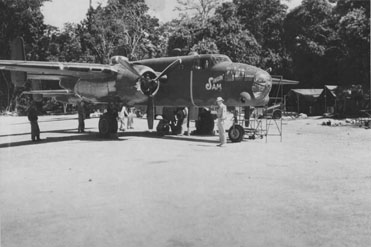B-25D/F-10-NC
History
At the time the United States entered World War II, the importance of aerial photography was known. A significant portion of the world had not been scientifically charted. Many of the existing maps were inadequate or just inaccurate. In 1942, the trimetrogon camera system was developed. Utilizing mainly 3 synchronized K-17 six inch cameras, the trimetrogon system allowed for easy photo mapping of large areas in a short period of time. The stability of the B-25 made it not only an excellent bomber, but also an excellent choice for aerial photography. A single B-25D/F-10-NC flying at 200 mph could map 20,000 square miles in four hours.
All of the B-25D/F-10-NC aircraft were taken directly from the Fairfax assembly line to the modification center for conversion. All of the armament as well as the armor was removed from the plane. This lightened the load by approximately 1,000 pounds. The unique "bug eye" nose was fitted to house the trimetrogon camera system. The aircraft usually retained it's standard reconnaissance camera aft of the bomb bay. Between 1942 and 1943, a total of 50 B-25D-NC bombers were converted into B-25D/F-10-NC aircraft.
The B-25 was no stranger to cameras. The usefulness of aerial reconnaissance was also well known to the military. Many B-25 bombers already had cameras mounted either just aft of the bomb bay, or later under the tail guns. Both of these camera systems were vital to measure the effectiveness of bomb runs. Typically, these cameras were K-17, K-20, K-21, or K-24 models. The cameras were set to continuously take pictures at a pre-defined time interval. Some systems would automatically start the cameras when the bomb bay doors were opened, and others could be manually started. The B-25D/F-10-NC was also used for aerial reconnaissance. The usefulness of photography "behind enemy lines" is obvious.
B-25D/F-10-NC bombers were used by several photo mapping and photo reconnaissance squadrons. They were initially used by the 311th Photo Wing. Later the 3rd, 7th, and 10th Photo Recon Squadron received B-25D/F-10-NCs. The 11th Tactical Recon Squadron, the 18th Combat Mapping Squadron, the 19th and 34th Photo Recon Squadrons also flew B-25D/F-10-NCs. The 91st Photo Mapping Squadron, the 101st Photo Bombardment Squadron and others were also known to have flown B-25D/F-10-NCs.
On November 7, 1957, Colonel Jack A. Simms had the idea to modify a B-25 to resemble Jimmy Doolittle's B-25B-NA. He wanted to present the plane at the upcoming Doolittle raider reunion planned for April 18, 1958. Every existing resource was to be used to meet the deadline. Since using an existing B-25B-NA was not possible, B-25D/F-10-NC SN 43-3374 was used. She was flown to the North American plant in Inglewood, California and reconfigured to visually appear as a B-25B-NA. The deadline was met and she now sits at the National Museum of the Air Force in Dayton, Ohio.
B-25D/F-10-NC Specs |
- Model: B-25D/F-10-NC
- Total Produced: 50 (all modified from B-25Ds)
- Manufacturing Plant: Fairfax - Kansas City, Kansas
- First Test Flight: Unknown
- First Flight Crew: Unkown
- Engines: Wright R-2600-13
- Carburetors: Holley 1685HA
- Fuel Capacity:
- 2 forward wing cells, total 368 gallons
- 2 rear wing cells, total 302 gallons
- 2 wing auxiliary cells, total 304 gallons
- 2 side waist ferry tanks, total 125 gallons
- Droppable bomb bay tank 335 gallons
- 1 fixed ferry tank 585 gallons
- Armament:
- None
- Armor Protection: None
- Weights:
- Empty: About 19,000 lbs.
- Max: 36,500 lbs.
- Speed (Max): 284 mph at 15,000 feet
- Service Ceiling: 21,200 ft
- Range: 1,500 miles
- Crew:
- Pilot, co-pilot, navigator, radio operator, photographer
- Production by year:
- 1942-1943: 46
- First Airplane Accepted: November 1, 1942
- Last Airplane Accepted: October 31, 1943
| Model | NAA Contract | SN | NAA # | # Produced |
|---|---|---|---|---|
| B-25/F-10-NC | NA-87/NA-100 | varies | varies | 50 |
- NAA Contract:
- NA-87 signed February 24, 1941
- Major Visual Production Block Changes:
- Shortened exhaust
- Closed tail skid design
- Unique "bug eye" nose adapted for camera use
- Notable Aircraft:
- 43-3374 B-25D-30-NC modified to a B-25/F-10-NC and reconfigured to resemble Jimmy Doolittle's B-25B-NA post war.
B-25Ds Modified as F-10s |
| SN# | SN# | SN# | SN# | SN# |
|---|---|---|---|---|
| 41-29875 | 41-29886 | 41-29984 | 41-30426 | 43-3419 |
| 41-29876 | 41-29887 | 41-29987 | 41-30427 | 43-3433 |
| 41-29877 | 41-29888 | 41-29988 | 41-30554 | 43-3434 |
| 41-29878 | 41-29924 | 41-29989 | 41-30627 | 43-3437 |
| 41-29879 | 41-29926 | 41-29990 | 43-3371 | 43-3438 |
| 41-29880 | 41-29927 | 41-29991 | 43-3372 | 43-3439 |
| 41-29881 | 41-29929 | 41-30132 | 43-3373 | 43-3440 |
| 41-29883 | 41-29930 | 41-30181 | 43-3374 | 43-3444 |
| 41-29884 | 41-29932 | 41-30195 | 43-3376 | 43-3446 |
| 41-29885 | 41-29970 | 41-30245 | 43-3416 |




